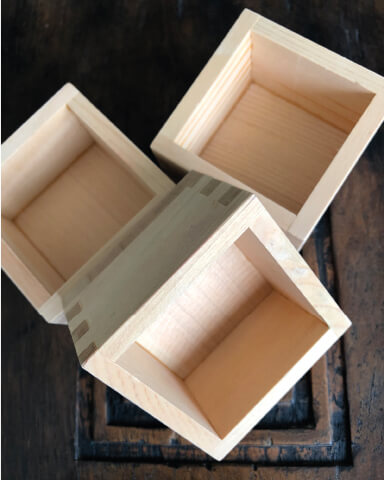You can find your favorite sake…
Sake has a millennium old tradition in Japan and knows
infinite subtleties. Here is the basic information
to enter the world of sake.
Sake can be found on the wine lists of more and more restaurants, because sake not only goes well with many Japanese dishes, but is also a delight on its own. A good sommelier can advise you on the choice of sake. However, to help you ask the right questions the next time you buy sake or talk to the sommelier, here is some basic information on choosing sake.
The main ingredients of sake are rice and water. In Japan, about 270 different varieties of rice are grown, including about 100 varieties of rice, which are particularly suitable for making sake.
The white core of the rice grain, called shinpaku, is important. Before sake is made, the rice grains are peeled. In this way, mainly the kernel of the rice grain with the starch it contains and only a small proportion of the proteins, fats and minerals of the layers surrounding the kernel are left. This allows the subsequent fermentation process to be as controlled as possible.
Sake Classification
Unlike the complex system of wine classification, the classification of sake is relatively simple. It is determined by two factors: Firstly, the amount of the outer husks of the rice grain that are peeled off and, secondly, whether the master brewer has added alcohol to the sake and thus influenced the smell and taste of the sake.
The more the rice is peeled, the higher the quality, as the sake is lighter and has a finer fragrance.
The graphic in the GloriousMe download shows the classification of sake. Premium sake represents only about thirty percent of the total market and is still relatively rare outside Japan. So be happy to see a premium sake on the wine list or at your sake retailer. The remaining sake varieties (futushu) are also considered quality products, comparable to a table wine, and are usually served with food. Premium sake, on the other hand, is preferably enjoyed with food on festive occasions, but is mainly celebrated without food. The regulations of premium sake can be compared roughly to the purity law of beer. In the case of the Futushu varieties, which represent the lion’s share of the market, there are far more possibilities to add flavours, colourings or other alcohol in the production process.
Junmai Daiginjo and Dainginjo
Junmai Daiginjo and Daiginjo are the absolute top products. Junmai Daiginjo, which is produced without the addition of alcohol, is lighter, more floral, while Dainginjo tastes somewhat stronger and more nuanced in expression.
These top sakes are drunk cold – this is the best way to develop the lightness and fine aromas. They are served as an aperitif or, like a whisky, are enjoyed at the end of a long day of relaxation.
Junmai Ginjo and Ginjo
In this category the fruity aromas and floral accents are more strongly expressed. Depending on the manufacturer and product, the aromas are reminiscent of apples, melons, pears or citrus fruits. Here too, the variant with added alcohol has a darker taste, expressing more umami. These sake varieties can be perfectly combined with dishes, be it with a perfectly fried steak or fish dishes.
Very fruity sake of the premium category is preferably drunk cold. However, it is also worth trying the sake when warmed. Depending on the sake, the warming can increase the pleasure. With some sakés, however, the aromas of the sake become too dominant when heated. These are better drunk cold.
Junmaj and Honjozo
These sorts of sake are stronger in expression and have a relatively high umami content. They partly taste more earthy and the fruit components are often more intense. Some have a higher proportion of acidity. Junmaj sake has a slightly stronger rice flavour compared to Honjozo.
If you are familiar with this classification, you will be considered a profound connoisseur of sake outside Japan.
What is the best way to enjoy sake?
Traditionally, sake was drunk from small rectangular wooden containers, which are still available in specialized shops. The subtle taste of wood generally goes well with sake.
If the light wooden tone is not desired, the cold version of sake is preferably drunk from small cylindrical vessels made of ceramic or porcelain. The position of the head when drinking the sake helps to emphasize its finish. Small, flat drinking bowls are preferred for the warm sake. Similar to tea, one bends to the bowl and thus absorbs the aromas more intensively with mouth and nose.
High-quality sake is increasingly being served in wine glasses, even in Japan.
The small elongated vessel in which sake is served is called Tokkuri. The Tokkuri should never be shaken and should not be lifted in front of the eyes to see if there is still sake in it. Drinking from the Tokkuri is considered completely unfashionable.
There are about 1200 sake producers in Japan, some of which produce up to 20 kinds of sake. The information on the labels of the sake bottles is strictly regulated by the government. The labels contain all the information you want to know about the contents. Unfortunately, to read the labels you need to know Japanese characters. Without knowledge of Japanese one could only read the alcohol content. But with the basic information about the classification of sake varieties you can ask the wine dealer or the Japanese supermarket for your preferred sake category and find your favourite sake over time.
Last not least.
Never ever call it rice-wine.
GM DOWNLOAD
>>>





